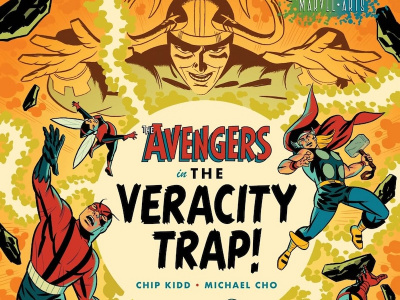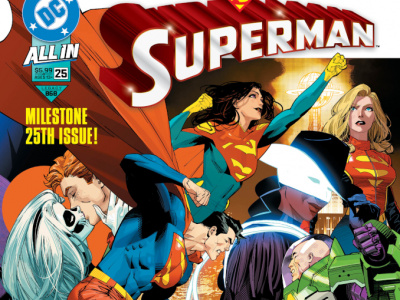
We recently spoke to Liza Coppola, Viz Media Vice President Sales and Marketing, about the North American manga and anime markets and Viz's place in them. In Part 1, we talk about Viz's TV-driven hits, the openings for shojo in the U.S. market, and the Viz anthology titles. In Part 2, we talk about the Viz consumers, manga production and frequency, and Viz's intellectual property launch strategy. In Part 3, we talk about cut and uncut anime editions, fan downloads, and DVD pricing. And in Part 4, we talk about American manga- and anime-influenced productions, and the bookstore, mass merchant, and comic store channels for manga.
Viz has had a couple of manga series with television exposure this year that have been really big hits -- Naruto and Fullmetal Alchemist. Those series are continuing next year, but are there any new series that you're launching next year that you think have that kind of potential?
We have quite a lot of things coming out; we have a lot more titles from the Shojo Beat line. Death Note is tracking very well -- we're very happy with how that's doing. There are also titles already out there for manga that may have some TV exposure coming up that will see an increase in the manga sales. We also just launched the novel for Fullmetal Alchemist, which did extremely well (a 30% increase over the other novel from the competing company that launched) so novels are also doing very well. Fullmetal Alchemist is one that, right out of the gate, saw very strong sales. We're adding the Profiles line. We're also doing a line of art books. So we are taking the manga properties that we have on television, expanding that a little bit more, and offering different lines for those properties.
You mentioned your shojo titles. Shojo's done very well here as manga, but less so as anime. 4Kids is experimenting with shojo for young audiences. What do you see going forward as the opportunities for shojo properties on TV, and more broadly, for shojo anime here.
I think it's going to be the same thing we've seen with Shonen Jump. The manga's been very popular, and then we have the anime. It will be the same thing for Shojo Beat. We're going to establish it through the magazine, and through the books, and then eventually there will be a Shojo Beat anime line as well. Actually, the first one that comes out under the Shojo Beat imprint is Kamikaze Girls.
There is definitely demand out there, and it is a little bit more tricky. When you look at all of the anime titles out there, a lot of them are predominantly targeted toward boys, and are more action titles. InuYasha and a lot of the other titles are targeted toward that demographic. Shojo is going to be a little bit more difficult, but we have extremely strong titles. We also have master rights for some of these properties. For example, for Kamikaze Girls we have a novel, we have the manga coming out, and we have the home video, so we are able to launch it collectively as one big property. I think that will help.
Do you see any openings for television for shojo?
I know that there's been some exploration of it; I don't know if anybody has really figured it out quite yet. I think broadcasters are more comfortable with properties that are targeted toward boys, and I think that's more a comfort level than anything else. But I do think they are realizing with manga that there's a strong readership for female out there, and that there is a potential for broadcast, but I don't think anybody has found a property that they're 100% comfortable that would do well on television. There are opportunities, but they may not be broadcast, it may be alternative channels. There's a lot of discussion out there in the home video market that maybe home video is one channel, but there might be other things like video on demand, we have the iPod that's coming out (I think ADV is doing something for the iPod?), all these different channels for some of these properties that may not fit on mainstream TV. There's the opportunity to look at these different channels and it may be that shojo isn't a good fit for Cartoon Network, or Kids WB, or Jetix, but it may work alternatively on these other channels.
We meet pretty regularly as a group and talk about where the market is at. We're very conscious of the home video market and we're also even more conscious of how anime fits into that home video market. We are in discussions about how to make sure that we tap into these different channels and whether it's a partnership with a broadcast channel or other ways of getting the properties out there.
Are you looking at an episode-by-episode download strategy?
I can't actually say at the moment. I can tell you that we're looking at home video and broadcast as a whole, but it's not something that we actually have the rights to. I don't think anybody officially has the rights to the property for download. What we do is sit down and look at all of the different channels that are out there and all the different things that are coming down. We do an industry update and look at all of the different opportunities, and we're all discussing collectively whether or not it's something that we want to pursue. For us it's a little bit more strenuous because we'll have to go back to Japan and actually have these discussions with our parent companies. We do look at what's happening in the industry and we do look at what's happening in other channels, but there's nothing in our immediate future.
Let's talk about the anthologies. You talked about how a property here might first get exposed to consumers in Shojo Beat, and then manga collections, and then the anime. Do you see the role of your anthologies in the U.S. similar to what they are in Japan, which is to expose new properties and take the best of those and publish collections?
Absolutely. We're definitely modeling after the way it's done in Japan. We're broadening it out and introducing it through the anthologies first. Just in the two years Shonen Jump's been out, readership and circulation is tremendous. It's in a lot of channels that the books aren't in yet. It's in the grocery store chains, it's in the convenience stores, it's in a much broader range of channels. And it's a great way for people to sample a little bit of each of the properties and decide which one they want to collect in book format. We are definitely following that same model that they have in Japan.
Is it a difference here that anything that is in Shonen Jump or Shojo Beat is ultimately destined for a collection, unlike in Japan where some things are tested and never go beyond the anthologies?
We take it on a case by case basis. Some things may come out in the magazine that may not come out in the book format, and some things may go directly to the book format. When we launched Shojo Beat magazine, we launched it with six original graphic novels, so it's not that it necessarily has to go through the magazine. We prefer that anything go through the magazine first, but in some cases, it may be different--it may go directly to book format.
How has the response been to Shojo Beat compared to Shonen Jump?
It's a little bit different because one has had so much more traction than the other. Shonen Jump has been out for three plus years, and Shojo Beat just launched this past summer, so you can't really compare it apples to apples yet. But we've gotten a good response when we're at the trade shows (San Diego Comic-Con, Anime Expo) and even from librarians. A couple of years ago they weren't that sold on the whole manga category. This past year, they seem to get it. 'We know what it is; we understand what it is; we love it; the kids love it.' And a lot of people came up to us and said, 'Thank you for putting out a version for the girl market.' Librarians said, 'We love Shonen Jump,' but we had so many people come in from the libraries and say, 'We need something that's shojo related.' We've also gotten tremendous response from consumers.







